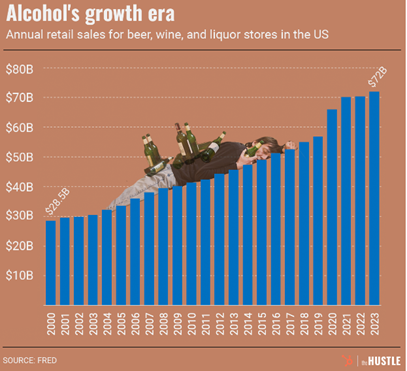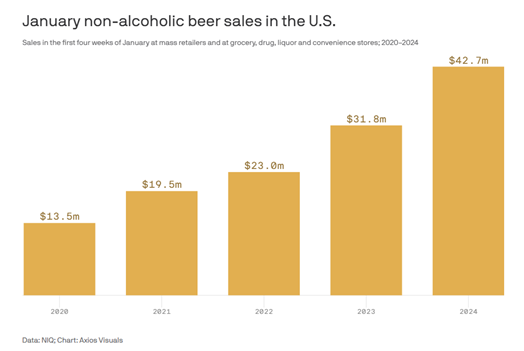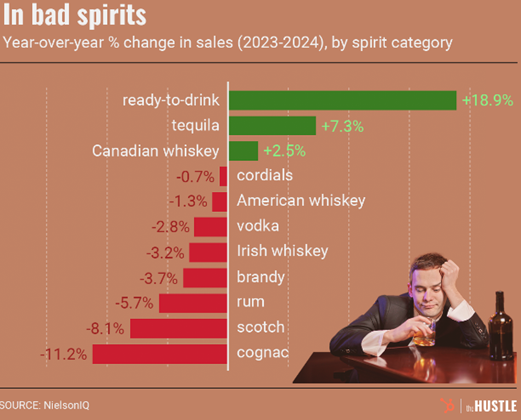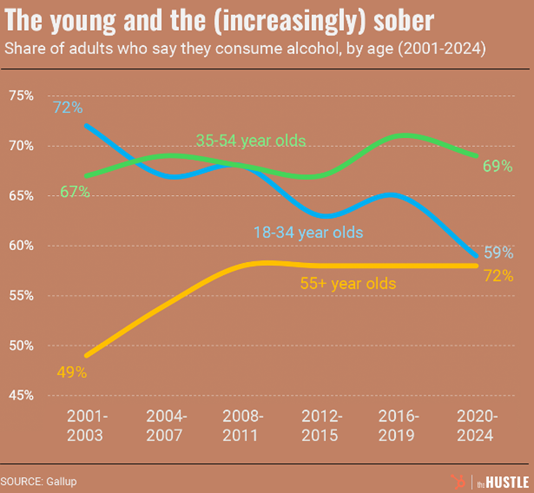This article explores what is driving the alcohol industry’s downturn and where the industry is headed.
Introduction
Every new year, millions of people commit to giving up various indulgences, such as sugar, meat, or social media, to name a few. Among these new year resolutions, “Dry January” has surged in popularity.
Following the festive season, this challenge encourages people to abstain from alcohol for the first month of the year. Experts cite benefits such as improved sleep, enhanced focus, and weight loss. However, as drinking habits evolve, this annual movement leaves the alcohol industry facing a prolonged hangover, one that lingers well beyond January.
One Nasty Hangover for the Alcohol Industry
Over the years, the alcohol industry has experienced consistent growth. While beer, wine, and spirits sales have occasionally slowed, the rise of one category has typically offset declines in others, maintaining overall industry stability.
According to IWSR, a global beverage data firm, demand remained resilient even during recessions, with wine and spirits showing modest growth followed by significant increases as economic conditions improved. Between 2000 and 2023, annual retail sales for beer, wine, and liquor stores in the US grew at a steady compound annual growth rate (CAGR) of 4.11%, based on FRED data.

Source: the HUSTLE
However, the industry’s trajectory began to shift in late 2022 and continued into 2023 and 2024, as spirits sales declined, leading to an overall downturn. According to Nielsen, the only spirits categories that experienced growth last year were tequila and Canadian whisky. Meanwhile, craft beer continued its downward trend, which started in the late 2000s, following a broader decline in mainstream beer.
Wine, on the other hand, has been stagnating since around 2018. Nielsen data shows that beer volumes fell by 2.9% last year, while wine saw a 4.4% decline. According to IWSR, alcohol volumes in the United States declined by 2.6% in 2023 and by 2.8% during the first seven months of 2024.
The outlook remains bleak, with market volume expected to stagnate through at least 2029. Even premium spirit brands have been affected, with Remy Cointreau reporting a nearly 23% drop last fall.
For years, Dry January has provided an opportunity for people to cut back on their alcohol consumption. More recently, its popularity has surged alongside the broader "sober curious" movement, particularly among younger generations, reshaping consumer preferences.
This year, 22% of US adults aged 21 and older reported participating in Dry January, a five-percentage-point increase from past years. Meanwhile, alcohol’s share of total beverage sales has declined from 45% in 2022 to 43% as of January 2024, reflecting a broader shift in consumer habits.
In 2023, sales of non-alcoholic beer, wine, and spirits reached $565 million, marking a 35% increase from 2022, according to NielsenIQ. Non-alcoholic beer has led the way, becoming the fastest-growing segment of the beer market.
Drivers of Decline in Alcohol Sales
The alcohol industry is experiencing a decline in sales due to a combination of changing consumer habits, economic pressures, and external disruptions. One of the notable factors contributing to this trend is the growing popularity of the Dry January challenge.
This movement encourages individuals to abstain from alcohol for the entire month of January, and research from the University of Sussex suggests that participants do not immediately return to heavy drinking once the challenge ends. Instead, many maintain reduced alcohol consumption throughout the year, reinforcing a broader cultural shift towards moderation.

The moderation trend has also been fuelled by rising prices across various sectors of the economy. As inflation pressures household budgets, consumers have adjusted their spending habits, either by reducing their overall alcohol consumption or opting for cheaper alternatives.
In addition to financial concerns, attitudes towards alcohol have evolved. Many individuals are reconsidering their drinking habits, leading to a decline in nightlife and social drinking. A 2023 Gallup survey found that 45% of Americans viewed even moderate drinking, defined as one to two drinks per day, as harmful to health, a significant increase compared to the mid-2000s.
While middle-aged and older Americans have largely maintained their drinking habits, younger generations have demonstrated a decline in alcohol consumption. According to Gallup, only 59% of 18-to-34-year-olds identified as alcohol consumers in recent years, compared to 72% in the early 2000s. This shift has coincided with a rise in marijuana use, with young people being the most likely demographic to consume cannabis.
Furthermore, Gen Z’s preferences have diverged from those of previous generations. While craft beer and IPAs were once popular among millennials, younger drinkers have shown a preference for less bitter, lower-alcohol beers and sweeter alternatives such as seltzers and cocktails.
The pandemic accelerated this trend, as many young adults who would have traditionally been introduced to social drinking in bars and restaurants instead spent their formative years at home, away from traditional drinking environments.
Another factor influencing alcohol consumption is the rising use of GLP-1 medications like Ozempic, which suppress appetite and, in some cases, reduce cravings for alcohol. According to the IWSR, approximately 12% of drinkers have reported using these drugs, though their long-term impact on the alcohol industry remains uncertain.
Beyond shifting consumer preferences, the industry has also been affected by significant supply chain disruptions. Despite the increasing demand for alcohol-free beverages, logistical challenges have hindered production and distribution.
Shipping delays have resulted in an estimated $24 billion worth of goods being stuck at California ports, while distilleries, both large and small, struggle to obtain essential materials such as bottles, cartons, and raw ingredients. These shortages have put additional pressure on the industry, limiting product availability and increasing costs.
Macroeconomic policies and trade regulations have further complicated the situation, particularly the prospect of new tariffs. If President Trump follows through with his proposal to impose a 25% tariff on imports from Canada and Mexico, the alcohol industry could face substantial price increases.
This would impact some of America’s most popular alcoholic beverages, including Mexican tequila and Canadian whisky, as well as the country’s top-selling beer brand, Modelo. Some businesses have responded by stockpiling high-demand products, particularly tequila, to mitigate potential price hikes. However, industry experts warn that consumers will ultimately bear the cost of these tariffs.
Smaller companies may have little choice but to pass on rising costs to consumers, according to Dave Williams, President of Bump Williams Consulting. Even major corporations like Constellation Brands (NYSE:STZ), which imports Modelo, Corona, and Casa Noble tequila, could see production costs spike by 16%, necessitating a price hike of around 4.5%, as estimated by Chris Carey, an equity analyst at Wells Fargo (NYSE:WFC).
If the Trump administration proceeds with its widespread tariff measures, the repercussions could extend beyond imports. Countries affected by US tariffs may impose retaliatory duties on American alcohol exports, potentially hurting domestic beer and spirits businesses.
Senior Director of Federal Affairs at the Brewers Association, Katie Marisic, warns that even if some products are excluded, tariffs on essential materials like Canadian malted barley or sheet aluminium could drive up production costs. In 2018, the previous round of steel and aluminium tariffs led to higher prices for craft beer cans, demonstrating how trade policies can have unintended consequences on the alcohol industry.
Overall, a combination of shifting consumer behaviours, economic pressures, pharmaceutical influences, and regulatory uncertainties is reshaping the alcohol market. As younger generations continue to move away from traditional drinking habits and external challenges mount, the industry must adapt to an increasingly complex and uncertain future.
The Future of the Alcohol Industry
The alcohol industry faces significant challenges as it navigates shifting consumer habits, the rise of GLP-1 medications, and the impact of tariffs. To adapt to these uncertainties, liquor companies may explore various strategies to sustain growth and profitability. One approach involves expanding their presence in rapidly growing markets across Asia and Africa, where economic development and changing demographics present new opportunities for alcohol consumption.
Another key strategy is premiumisation, a trend that has already gained traction in the industry. Many companies have focused on selling fewer litres at higher prices by introducing premium spirits priced at $50 and above. In the coming years, this strategy may extend to more affordable liquor categories, where brands will attempt to position $30 bottles as premium offerings, allowing them to increase their margins while maintaining volume sales.
Innovation is expected to play a crucial role in driving future growth, particularly in response to evolving consumer preferences and regulatory constraints. While tariffs may influence which alcoholic beverages gain popularity, the demand for non-alcoholic and low-alcohol alternatives continues to rise. Though these products currently represent a small fraction of overall alcohol sales, their market share is expanding, particularly in the form of ready-to-drink beverages such as canned cocktails and alcoholic teas.
Taste remains a determining factor in consumer acceptance of these alternatives. Some of the biggest names in the industry, including Guinness and Heineken, have heavily invested in technology to develop non-alcoholic beers that closely replicate the taste and texture of their alcoholic counterparts. Guinness, for example, has worked to ensure that its alcohol-free version, Guinness 0.0, maintains the iconic flavour and appearance of the original. Similarly, Athletic Brewing Company has gained prominence as a brand specialising exclusively in non-alcoholic beer, reflecting the growing consumer interest in such products.
Molson Coors (NYSE:TAP) has also capitalised on this trend by significantly expanding its non-alcoholic portfolio in the United States. Over the last 12 weeks of 2024, sales of its alcohol-free beer brands surged by 89%, securing the company a 2.1% share of the rapidly growing alcohol-free beer market, according to NIQ data. Beyond low- and no-alcohol beverages, brands are diversifying their product lines with innovations such as wines that are lower in sugar and calories, catering to health-conscious consumers seeking moderation without entirely abandoning alcohol.
Conclusion
Ultimately, the future of the alcohol industry may hinge on whether future generations’ growing preference for sobriety is a lasting cultural shift or a temporary trend. As companies continue to explore new market segments and refine their product offerings, they are likely to see sustained growth in both the low/no-alcohol category and premium product lines. These developments will shape the industry’s trajectory in the years ahead, determining how brands evolve to meet the demands of an increasingly health-conscious and selective consumer base.
